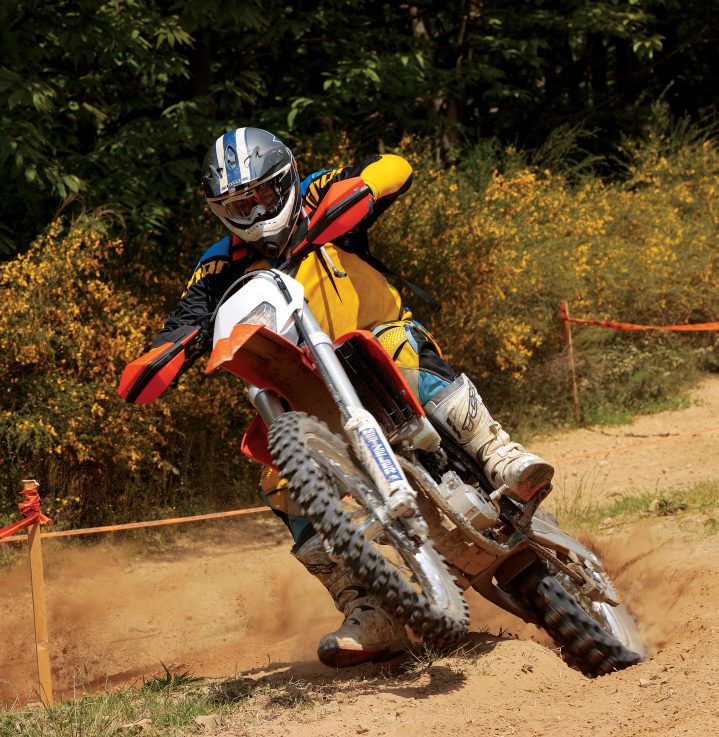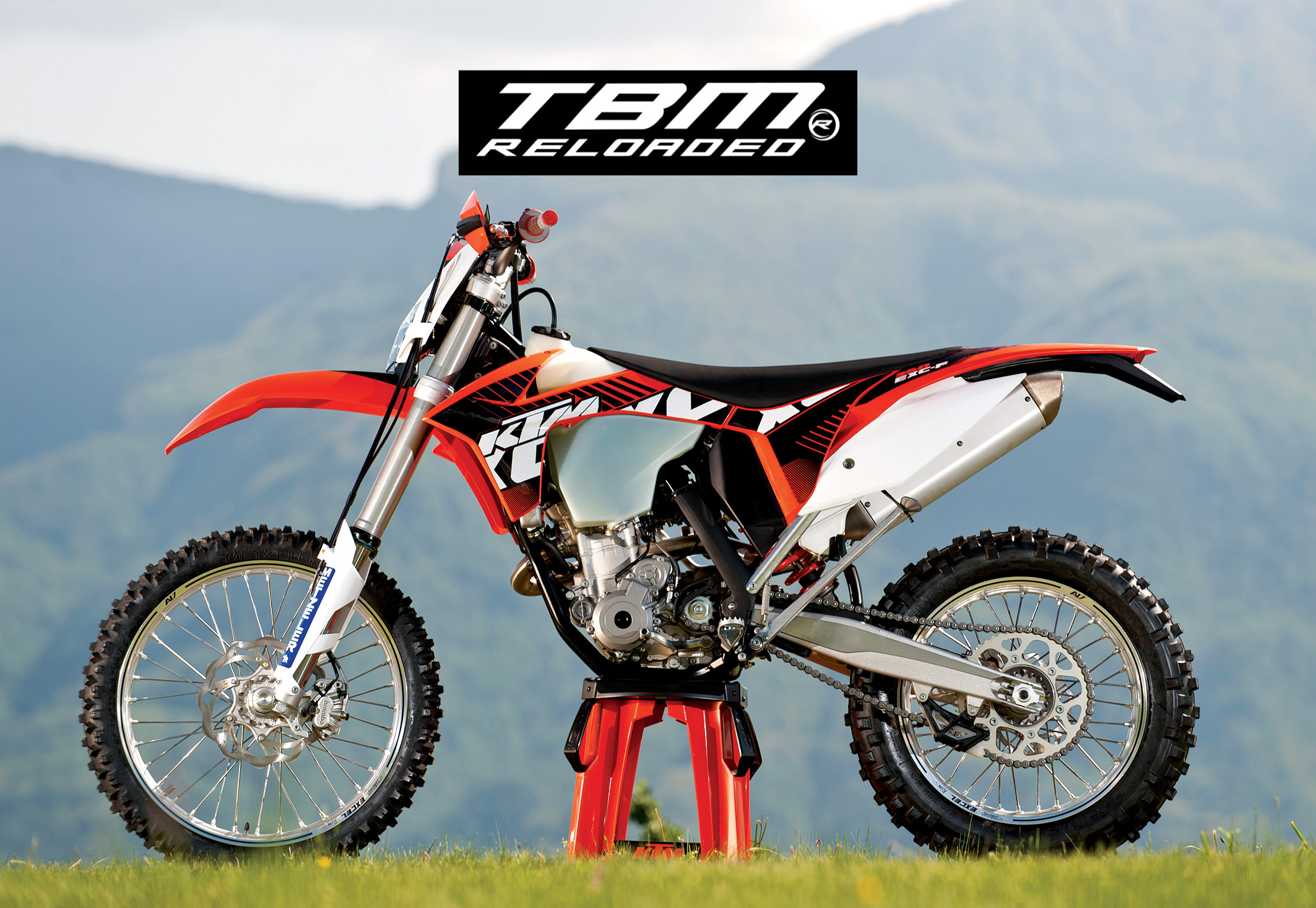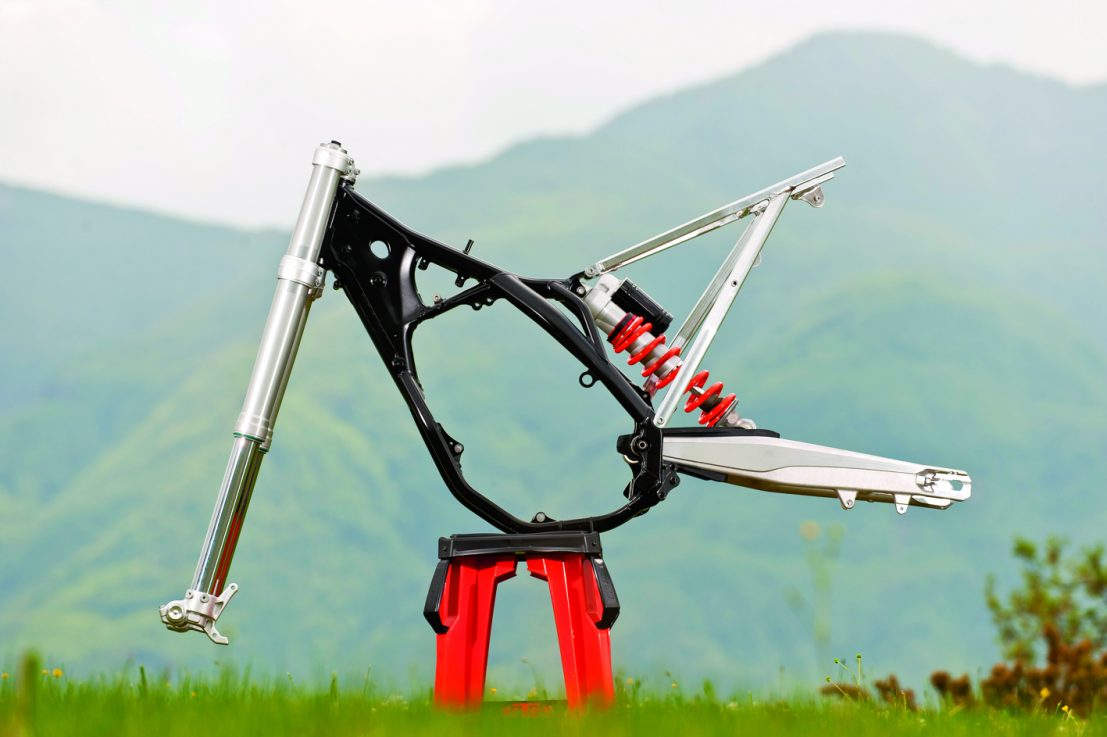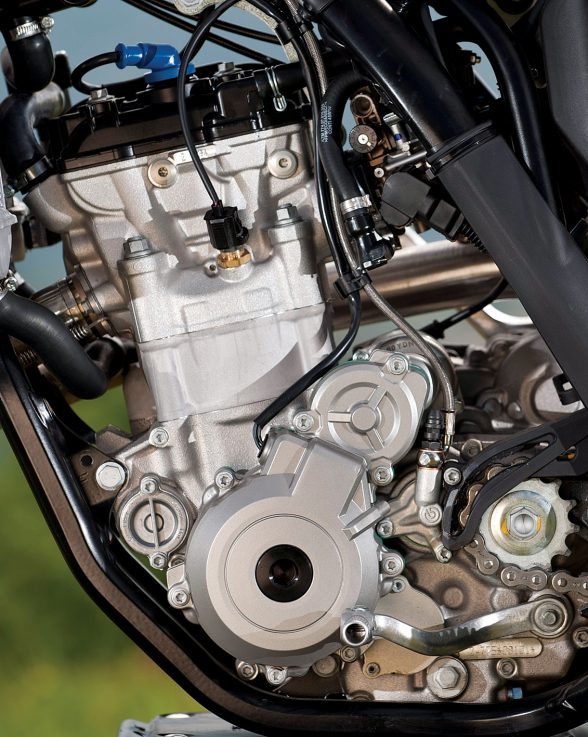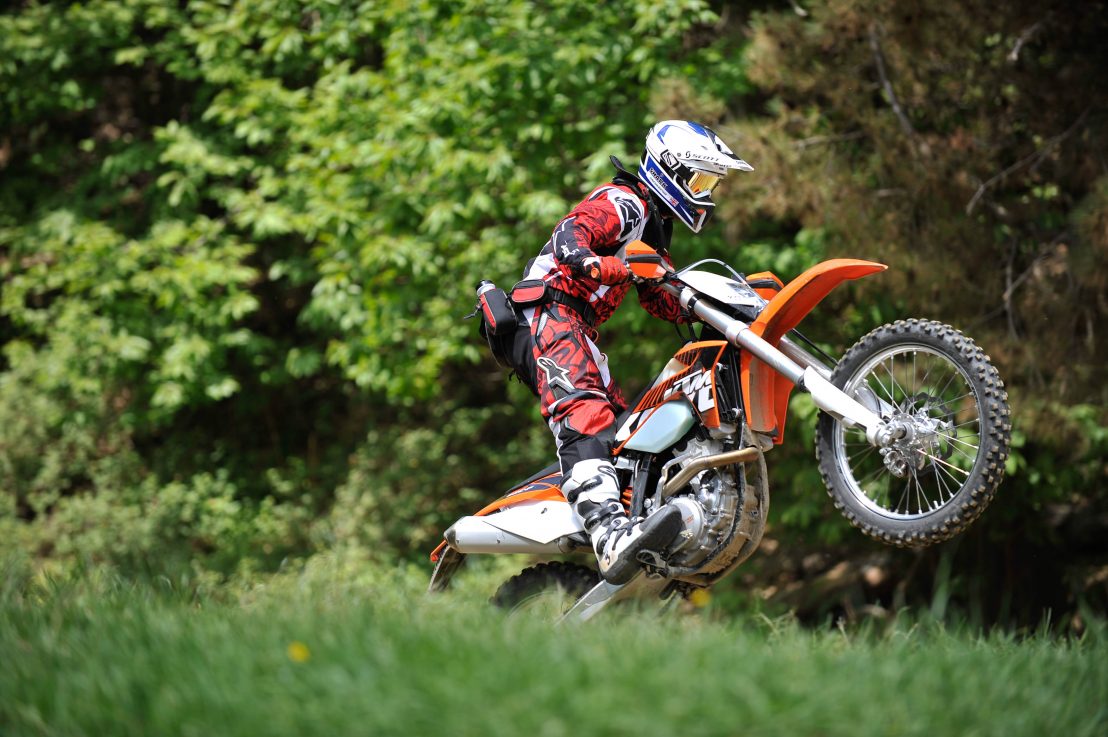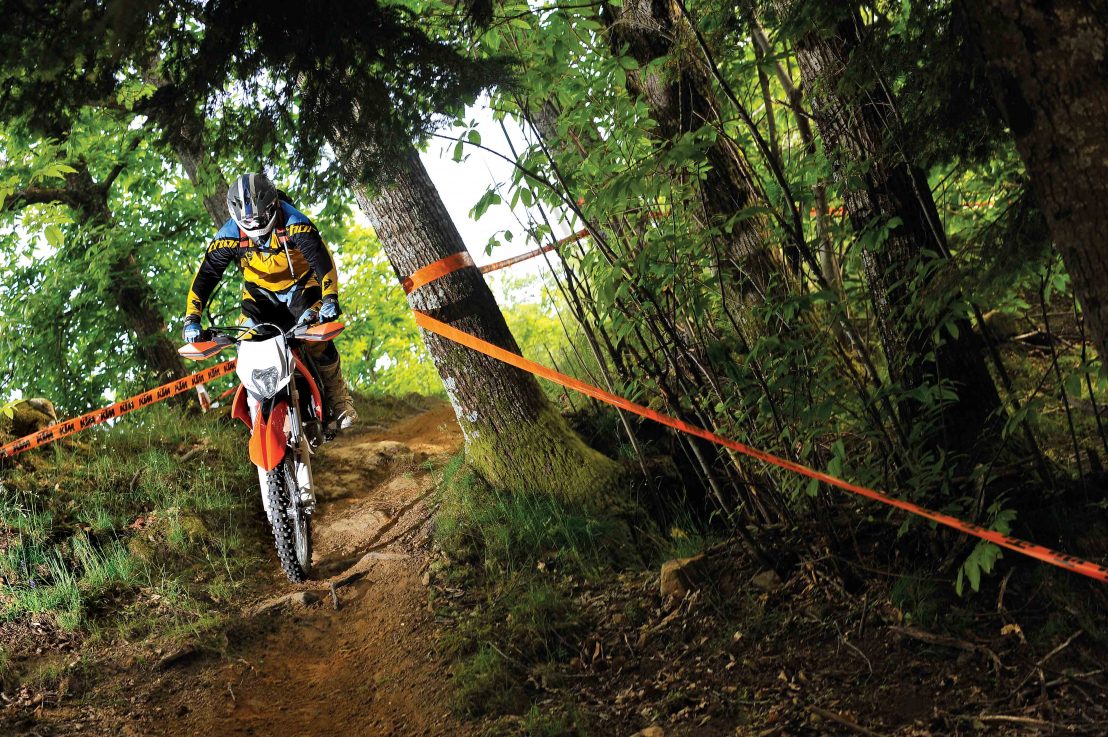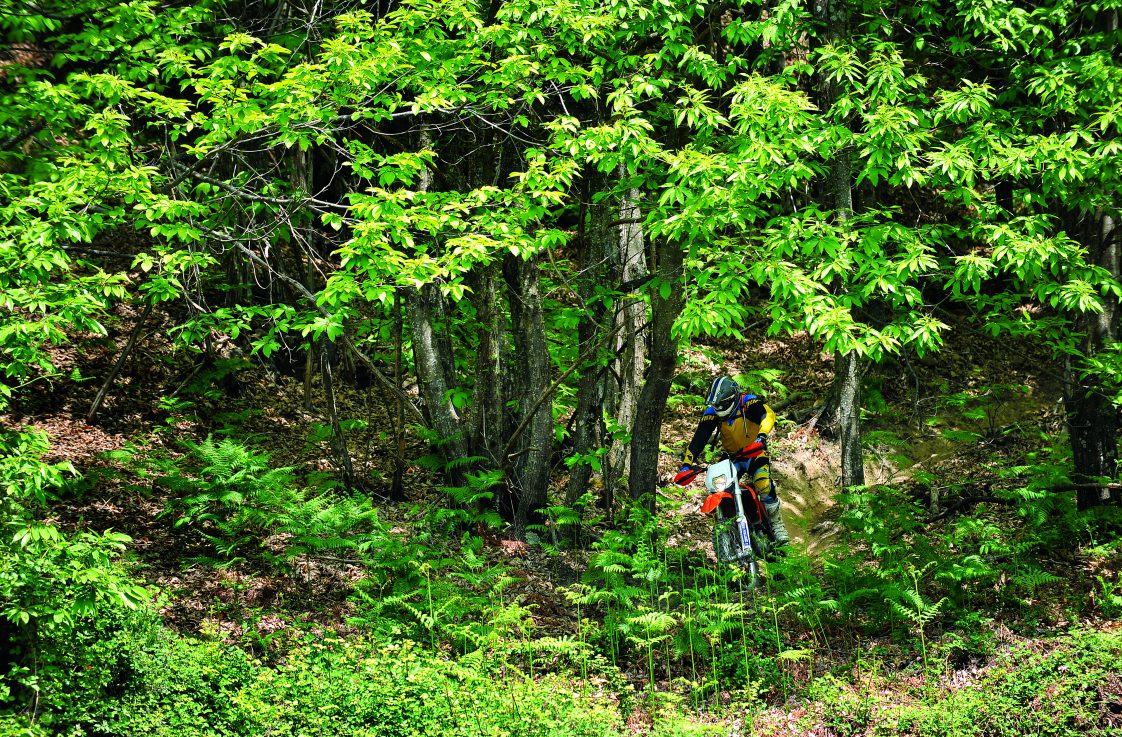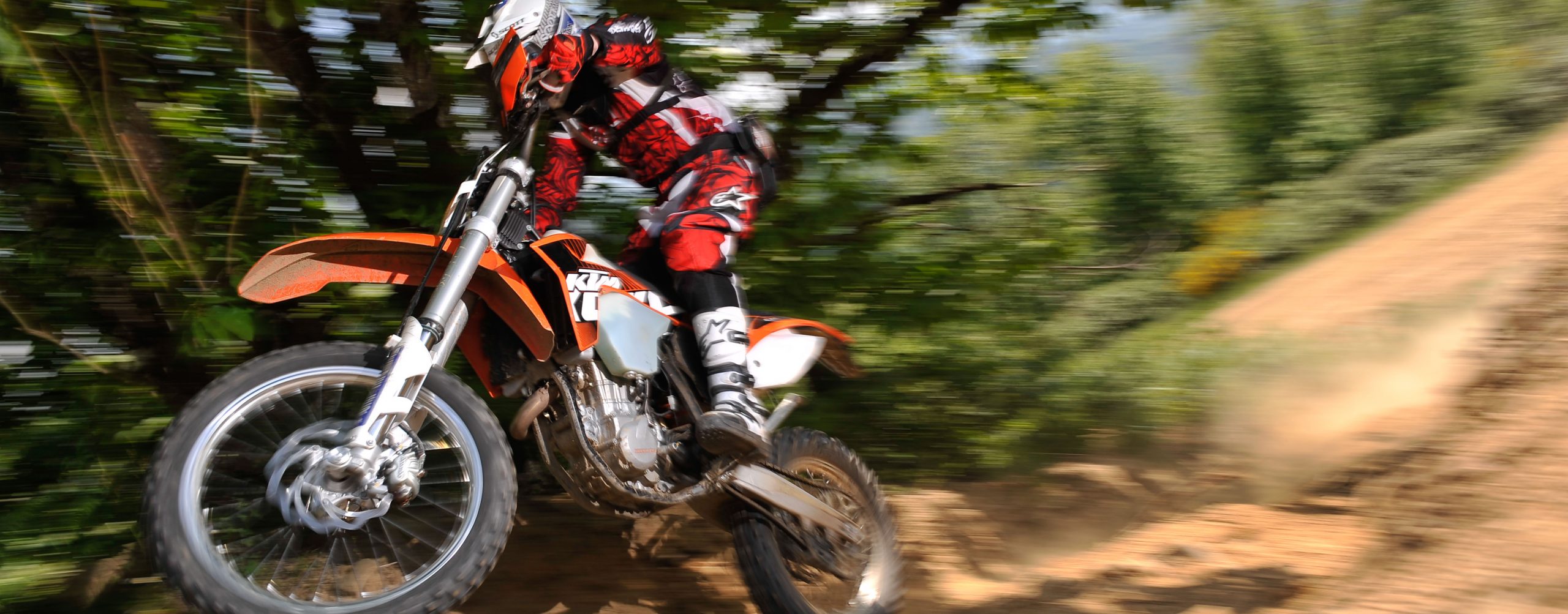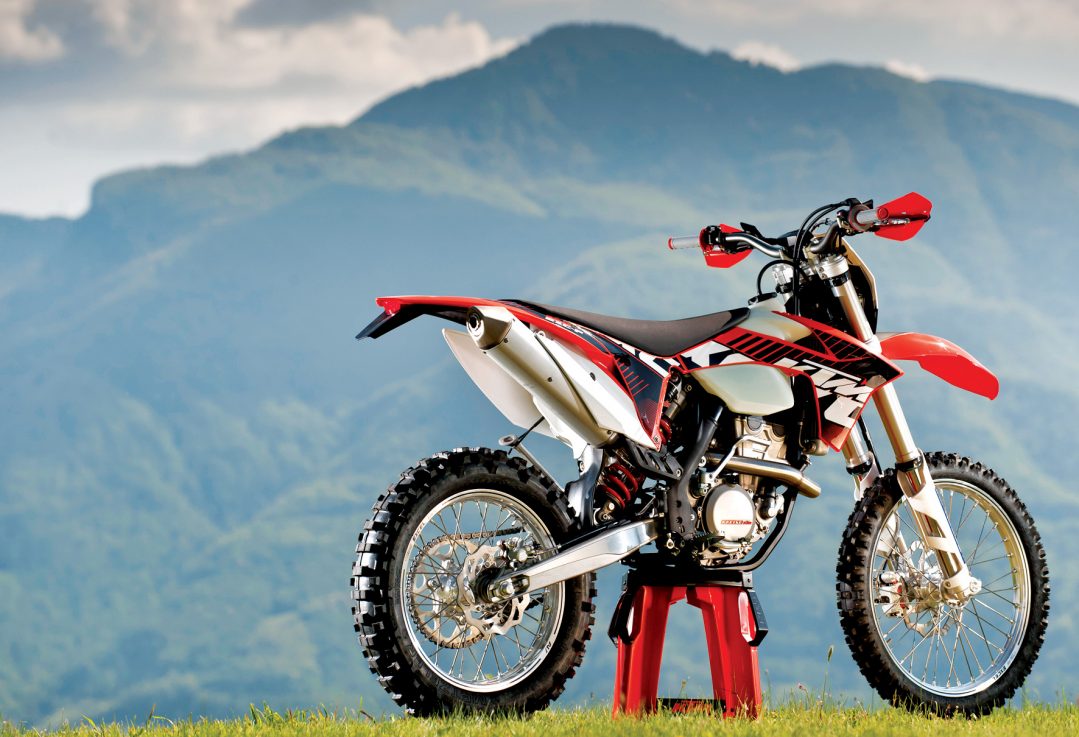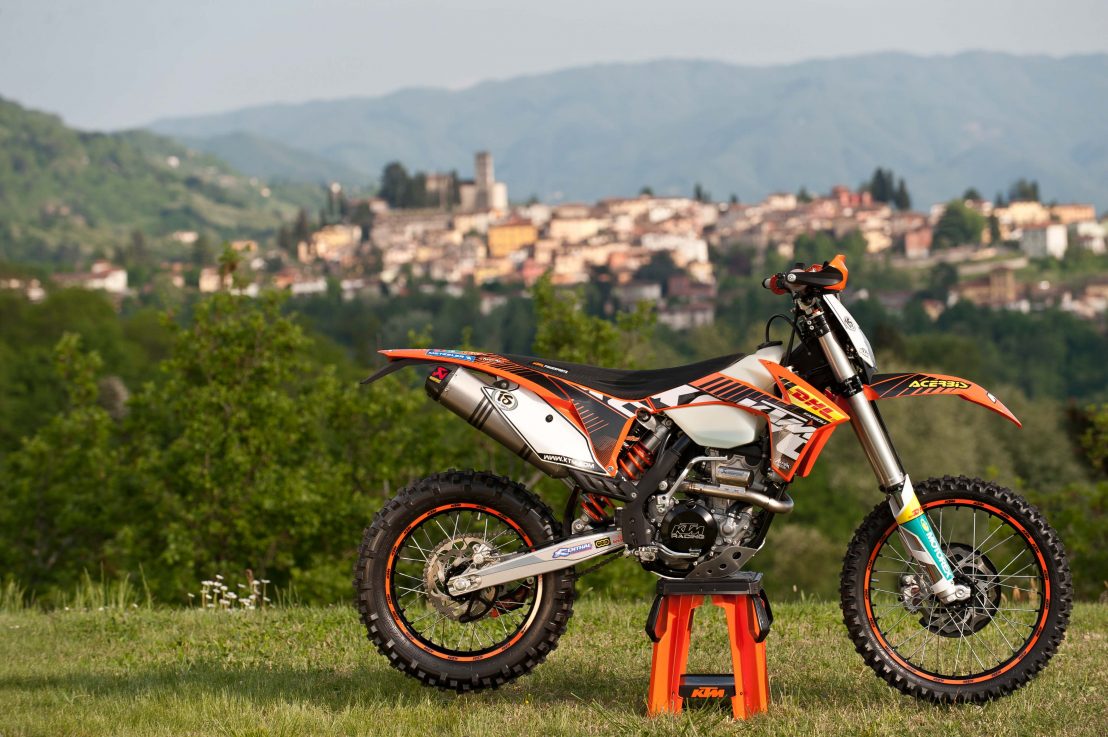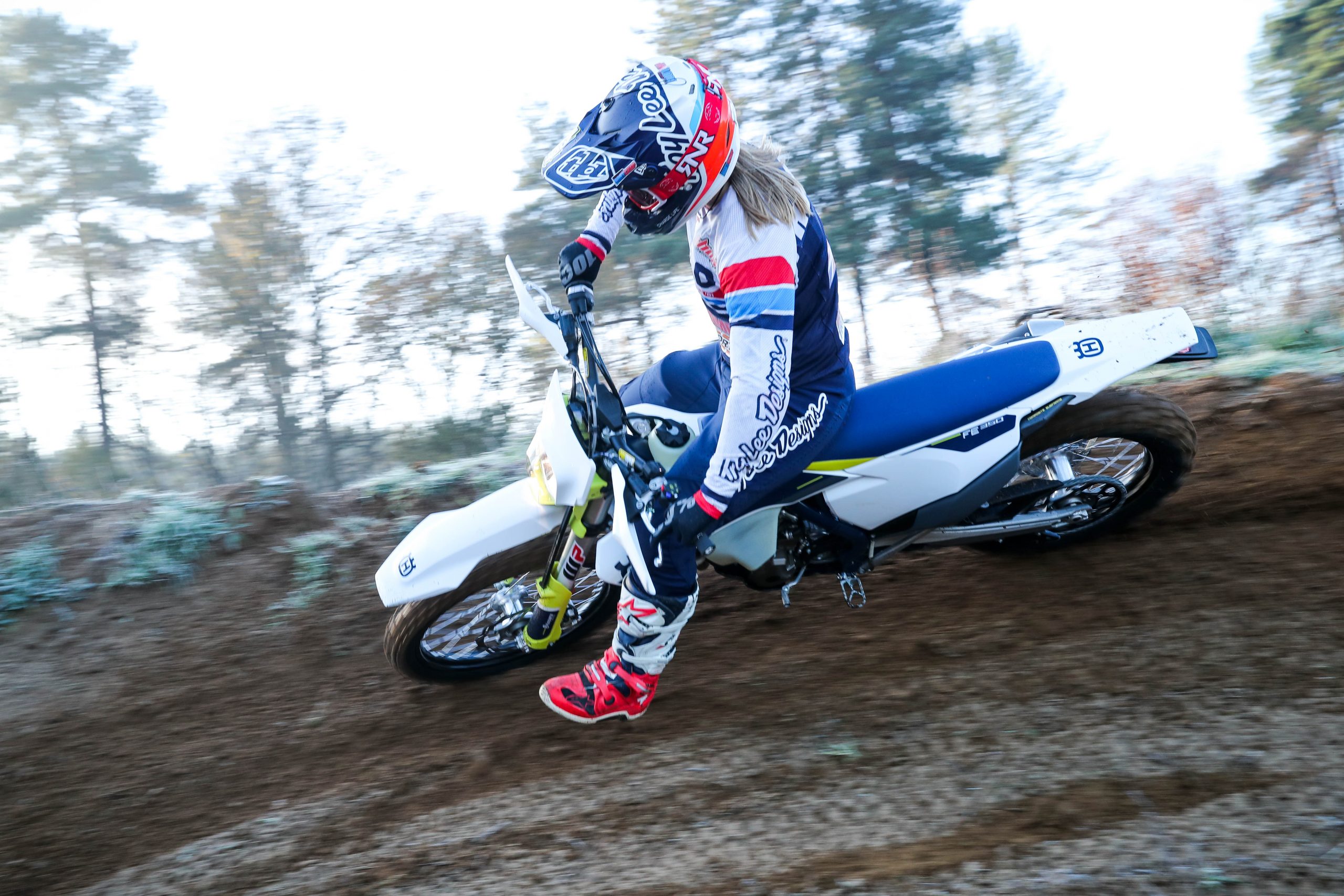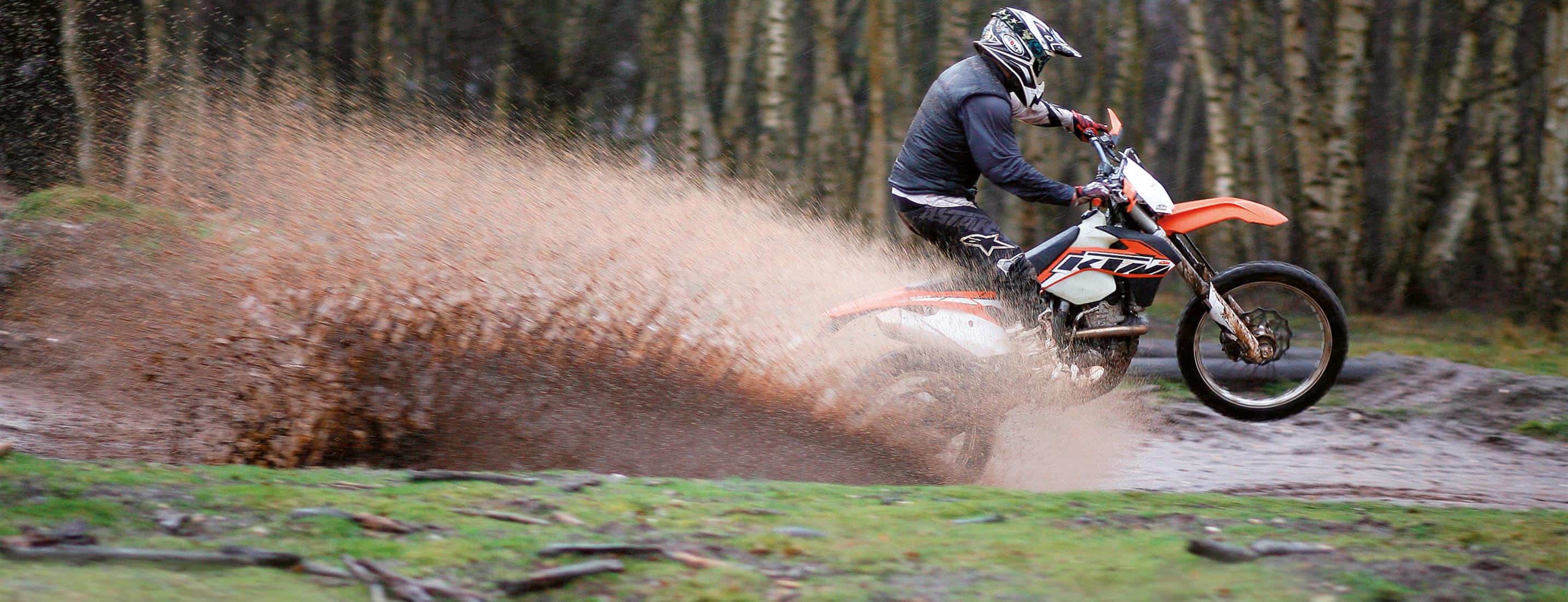words: Si Melber images: Marco Campelli (KTM)
I gotta’ admit although KTM were trumpeting the new 350’s arrival as something of a flagship model, it was the bike I least wanted to ride at the launch. Why? Because of my experience of the 350 so far, that’s why. This time last year I rode the 350SX-F and couldn’t see how it could possibly work in an enduro setting – too harsh, too powerful, too much. Then just a couple of months ago I rode the 350XC-F – a kind of cross-country, crossover model and once again found it too abrupt, too intense and too single-minded to work well in our environment. With its powerful MX engine overshadowing what was obviously a good chassis. Yes, you could trail ride it and race it (we did both), but our conclusions were that there were plenty of other machines that were better suited to the type of terrain we ride. In a nutshell I was worried that KTM’s uber-powerful 350 would fail to make the transformation from MX milestone to enduro excellence.
So having ridden it, what do I make of the new 350EXC-F?
Well let’s just say that there’s good and bad news. The good news is that the 350EXC-F has finally arrived. The bad news…? Well, I guess if you happen to be a rival manufacturer, I’d say that the bad news is exactly the same… that the KTM 350EXC-F has finally arrived!
It may well have marked the departure of the much-loved 400EXC, but within a minute of riding it, you will have forgotten all about the old clubman-favourite. Instead you’ll be laughing into your lid, howling into your helmet and, er… bawling into your bone-dome. This bike is not just good, it’s not just very good, it’s a deal-breaker.
Aspirational, inspirational and for all I know it may well be astro-physical, such is the way in which it seems to re-define the physics of riding a dirtbike. Once or twice in every decade, a machine comes along that resets our boundaries, redefining what we expect from a dirtbike. That bike is the 350EXC-F, and this is how it does it.
LOW COMP = HI FUN
Inside that twin-cam engine – modelled on the 250EXC-F lump and weighing an almost identical 28.5kg – is a flat-topped piston that when combined with a slightly longer cylinder than the SX-F, drops the compression ratio down from a lively 13.5 to a more sensible 12.3:1. That my friends, is crucial to managing the 350’s rideability and when combined with enduro-specific cams, a heavier crankshaft and a slightly different counter-balancer, produces a bike which is not only incredibly fun to ride, but also amazingly potent, yet at the same time surprisingly docile for the average rider.
Let me be completely up-front about this – because this is key to the KTM’s acceptance in this marketplace – had KTM lost sight of what the EXC tag stands for (rideability, raceability, but above all… useable fun) then they may well have produced a title-winning racer but failed to shift barely any units to the general public. A bit like Aprilia did with their 450RXV when Merriman took it to E2 victory. Fortunately for them (and us) KTM didn’t. From the moment you park butt on the 350EXC-F’s saddle you realise that the experience is going to be revelatory.
The bike is slim – like the 250EXC-F – and it feels even slimmer this year thanks to the redesigned bodywork. So you feel like you’re riding a small/light/controllable bike. Confidence aboard a motorcycle is everything, because in my head it gives me the green light to explore and exploit a bike’s limits, safe in the knowledge that I’m gonna’ stay out of trouble.
The EXC350 feels like that – not so small that taller riders won’t like it (unless you happen to be over about six-foot-four), and not so small that it feels cramped (though it certainly feels well-packaged). Nope, KTM have pitched it just about right so it’s big enough to feel secure on the going, yet small enough to hustle easily through rocks and trees.
Once or twice in every decade, a machine comes along that resets our boundaries, redefining what we expect from a dirtbike. That bike is the 350EXC-F
Si Melber, TBM July 2011
SELL YOUR 450
Power is kind of irrelevant in the dirtbike world but let’s just say that KTM’s claim that the 350 will match or exceed the majority of 450s out there (including their own), is not at all far-fetched. What it won’t do of course is match them for torque, but since power is nothing without control, the more moderate torque compared with a 450 is actually very much to your advantage. For instance it means that while the 350EXC-F can be easily persuaded to break traction on a loamy corner (or anywhere for that matter) to sit the back-end out, it doesn’t spin up at the merest provocation, nor when you’re least expecting it.
And while there’s a fantastic flurry of performance available through the bike’s ample midrange, it’s not hard to dominate and utilise that performance – indeed part of where the 350 excels over EVERY current 450 I believe is in its ability to drive through the low to midrange, rather than simply spinning its tyre and generating roost.
I’m in awe at how KTM have achieved this usability on the EXC, because it really is quite unique among four-stroke enduro bikes. But I suspect ultimately it comes down to the choice of capacity as well as sensible engineering. There’s power available low-down should you need it (for lugging if you get caught in the wrong gear) but it’s not excessive. Then there’s a strong and exceedingly healthy midrange (without any steps in the delivery I should add) which is all you could want for – but again it’s not excessive. It is however capable of propelling the bike along very fast if you want it to. And all this without recourse to the bike’s redline. Because the midrange is so punchy, so willing and so utterly exuberant, you never feel like reaching for the bike’s 12000rpm redline.
Alright, if you do lots of flat-field hare-&-hounds you might use the top-end once or twice a lap for a blast down the straights – but you never EVER need it on the going because there’s simply so much midrange punch available that riding it in the upper reaches of the rev range would almost certainly turn out to be slower than short-shifting and feeding it gears.
It’s important to get this point across because lots of people will no doubt be considering a 350 and wondering about trading up from a 250F or down from a 450. To all 250F owners I say… just do it, you’ll be blown away by the bike! To the 450 owners I say sacrifice a little of the torque you probably don’t need anyway, for immense driveability and way superior handling. This bike is every bit as quick as a 450 in any off-road setting – even open going! The difference is that it’s way, way easier to cover broken ground on the 350 than it is on any 450. Every turn, every root, every rock-step, every hill climb is despatched in a quicker and simpler manner than on a 450, but the real difference comes in the corners.
Unlike a 450 the 350 doesn’t end up on the outside of the turn every time… and though you can easily point it there if you want it to roost out of a berm or turn off the opposite bank of a track, you won’t end up there automatically – in other words you generally have a choice of lines, which is just what you need when racing, and it’s a real bonus when trail riding, too. Because of the way the 350 rides, it’s lighter on its feet, more pointable, less ploughy and far less cumbersome to get turned. And that makes it safer too! Bends which tighten up on you, slippery corners with steep drop-offs, or simply unexpected hazards that appear out of nowhere are far more easily dealt with thanks to the bike’s greater manoeuvrability and lack of impetus. Trail riders will love it. Enduro riders will desire it!
ON THE DIRT
Given that this was the launch test – in Italy – on the sort of rocky going that’s not all that common in the UK, I won’t dwell on the bike’s suspension characteristics at this stage, with one exception, that I felt the front forks were marginally on the firm side, though I never once adjusted the clickers because I was simply having too much fun riding the thing stupidly fast. The rear suspension felt absolutely sublime, 100 percent of the time. Nuff said.
Instead, I want to dwell a little longer on the concept of a 350 dirtbike and maybe talk a little more about its dynamics on the trail. Anyone that’s been riding dirt bikes for a few years will know that 350 thumpers are not a new concept. Back in the late Eighties KTM had their own LC4 version which was slow, heavy and a pig to start. CCM had one of those too. Husky’s 350 was a lovely little tool – if a little lacking in power, and of course Suzuki’s DR350 set the standard for trail riders for almost a decade, while Yamaha’s twin-cam XT350 remained in production for years. Even Honda used to build an XR350, and Beta currently offer both a 350 trailbike and a twin-cam enduro bike in their present lineup.
But with their EXC, KTM have quite rightly claimed this capacity class for their own, because there really is nothing like it out there. I really must stress that because of the way KTM have concentrated on making this bike ridable rather than simply powerful, it feels almost like an orange XR – a bike for the masses – an RS Escort of a bike (albeit with Impreza performance). Of course it’s more powerful, and a good deal more potent than any equivalent-sized XR, but at the same time it’s kind of easier to use than any XR as well – it starts at the push of a button, it feels way lighter, the clutch pull is lighter the throttle pull is lighter, the suspension is plusher and better damped – hell, even the seat felt fairly supple on the ones I rode. And with six speeds and a creamy smooth motor it even feels good on the road too. That’s what 15 years of development has achieved since the XR400R was launched.
And it handles way better than any XR I’ve ridden, gobbling up the terrain in a delicious flurry of creamy thumper power and supreme neutrality through the turns. Power aside, the riding experience reminds you of the 250EXC-F in as much as you point the bike and it goes there without you having to fight it – and you can put it where you want either by steering or just using the throttle. Of course the principal difference is that this machine has ten more horsepower – all of which appears to be available at ALL times. This is a bike that accelerates up steep stony climbs, powers briskly out of turns without needing thrashing, and romps along a track almost irrespective of the gear you’ve selected.
The power delivery is much more reminiscent of a 450 or 400, but with the precision of steering and deftness of touch that’s more 250F. But whereas you have to rev 250 thumpers to extract reasonable speed from them, the 350 is much more midrangey – more twist and go. Not quite as lazy as a 450 (you’re better off downchanging twice into a tight turn to maintain good momentum on the exit), but if anything it seems to propel you forwards even faster than a 450 because it hooks up and drives so much easier, and you don’t find yourself fighting the weight. Also it’s not the sort of bike that you need to thrash to get the best out of. Yes it’ll rev, but just working the midrange is what the EXC does best.
In many ways it offers the best of both worlds because it has the power to lift the front end over hidden obstacles, or blast past a slower rider without having to wait, yet it offers the controllability of a light 250 in tighter going.
A WORD OF WARNING
However… a word of warning! Because the 350EXC-F feels – and is – very light, it responds much more dynamically to rider input than a 450, so if you lean too far forwards over the bars when accelerating then you can unsettle the bike’s drive (slightly) by unweighting the rear, and likewise you don’t need to use so much rearward shift to find drive, nor much lateral movement to make the bike turn. In other words if you’re coming off a 450 where the bike feels planted at all times due to its mass and momentum, the 350 can feel almost skittish by comparison. I don’t mean unstable, but dynamically it’s a slightly different proposition.
They say that modern-day jet fighters are designed to be unstable in the air in order to make them turn faster, and that they require the calculations of powerful onboard computers to keep them stable. Riding the 350EXC-F feels a bit like that – especially if you’re coming off a lumbering 450. Because it responds so swiftly to rider input (without feeling the least bit twichy or nervous in its handling) that you can barely believe how little work you have to do to ride the thing.
Like any dirtbike, a bit of body English is necessary, but just don’t go exaggerating your movements because on the 350 you simply don’t have to. Keep your weight centred and your body movements to a minimum and not only will you save time and effort, but you’ll be rewarded with a much more controlled ride.
If you’re a cross-country racer reading this and thinking that handling’s all well and good but will a 350 be powerful enough for closed-course racing, then take my word for it – it will! It’s more than fast enough to hang with any 450 – just ask Johnny Aubert, who’s riding one in E2 this year! But rather than simply opting for outright performance, what the EXC model does is take the concept of enjoyment of riding a dirtbike on rough terrain, and develop it into something that’s uniquely fast yet fun. I don’t think the 350’s suitable for everyone though – it may feel XR-like in its approachability, but this bike has teeth and can bite back if you abuse it.
Older hands among you may well remember the launch of the 900cc Honda FireBlade roadbike way back in 1992, a bike that redefined the word ‘sportsbike’. Prior to the launch of the original ‘Blade, sportsbikes had been heavyweight missiles – fast but fearsome machinery like the mighty FZR1000EXUP. Then along came the small and ‘relatively’ lightweight Blade and turned the sportsbike market on its head. Those original Blades felt barely any bigger than the CBR600 of the time, but they offered litre-bike performance, and they could bite the unwary.
And in a way the 350 reminds me of that bike and that time – obviously I don’t mean in terms of performance (or necessarily the Blade’s twitchy handling on its unconventional 16in front wheel), but in the way that its concept was ahead of its time and that its launch upset the established litre bike market and stole a lead on rival manufacturers that took them years to catch up.
Because, be honest with yourself, why on earth would you want a 450 right now, when you know that the 350 delivers the goods in a much cooler manner? Not for the performance advantage that’s for sure. And anyway, no 450 I’ve ever ridden, handles like this machine does (and that includes the 450 Berg!).
Alright, I understand if you’re heavier than about 110kg you might want the extra clout that a 450 engine delivers, but for the majority of riders I simply can’t see the point. Why make life difficult for yourself when this bike offers 450 performance with 250 dynamics?
In a year or so’s time I can see every enduro track in the south of England bristling with 350s, and every one of TBM columnist Chris Evans’s punters, so armed. That is if they can get their hands on one. The recession has meant that KTM UK are ordering in smaller numbers these days, so the likelihood is that the 350s will be in relatively short supply. I know TBM readers value our unequivocal stance on new bikes – good or bad – so let’s just hope anyone reading this is in no doubt as to what we think of this new machine. Congratulations to KTM’s engineers for curbing their enthusiasm to make the 350 needlessly powerful. Instead they’ve built a proper EXC that’s as comfortable on the trail as a contented cowboy and at home on the racetrack as an inaudible PA system. I loved it.
2012 KTM 350EXC-F
SPECIFICATION
Capacity: 349.7cc
Bore & stroke: 88 x 57.5mm
Fuelling: Keihin EFI, 42mm
Gearbox: Six speed
Forks: WP USD 48mm
Shock WP PDS
Wheelbase: 1,482mm
Seat height: 970mm
Fuel capacity: 9.5l
Weight: 107.5kg
Price in 2011: £6895
